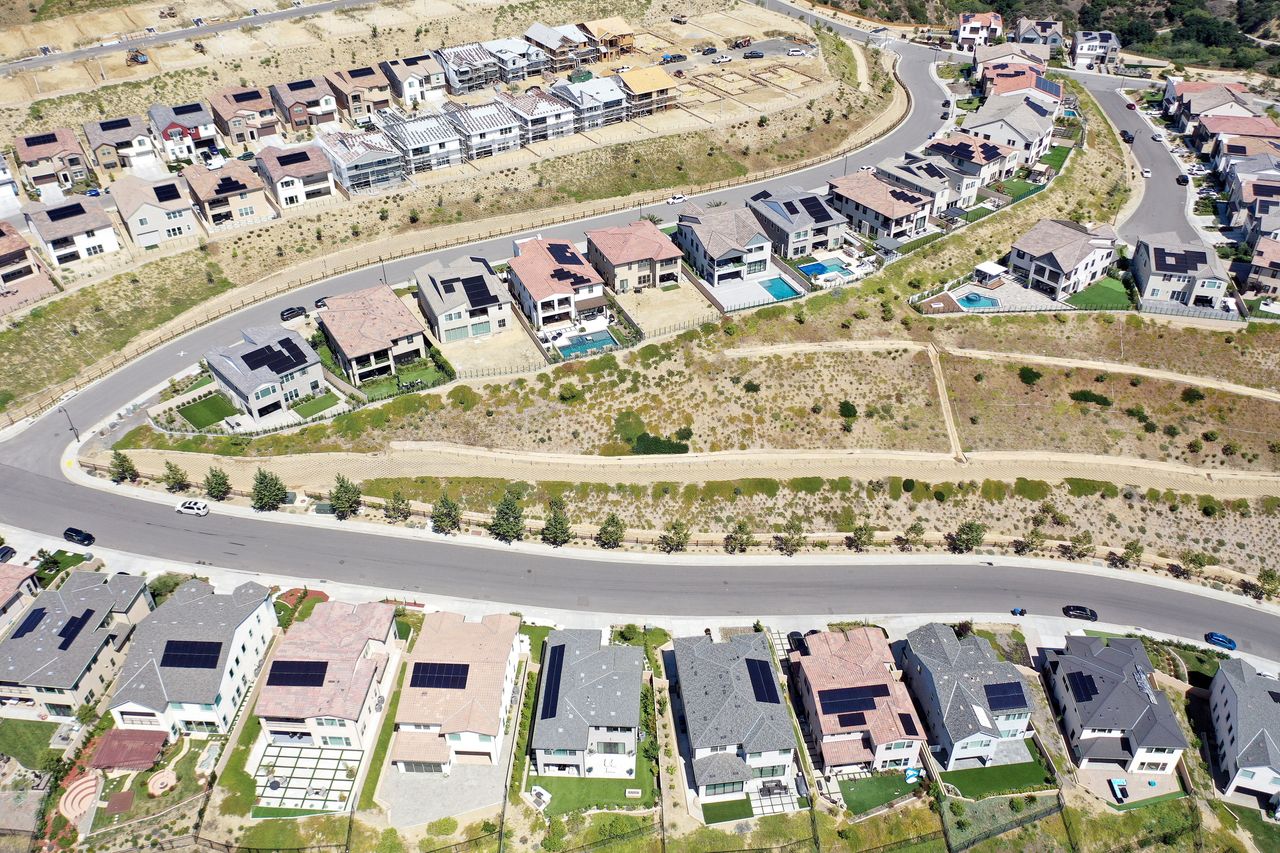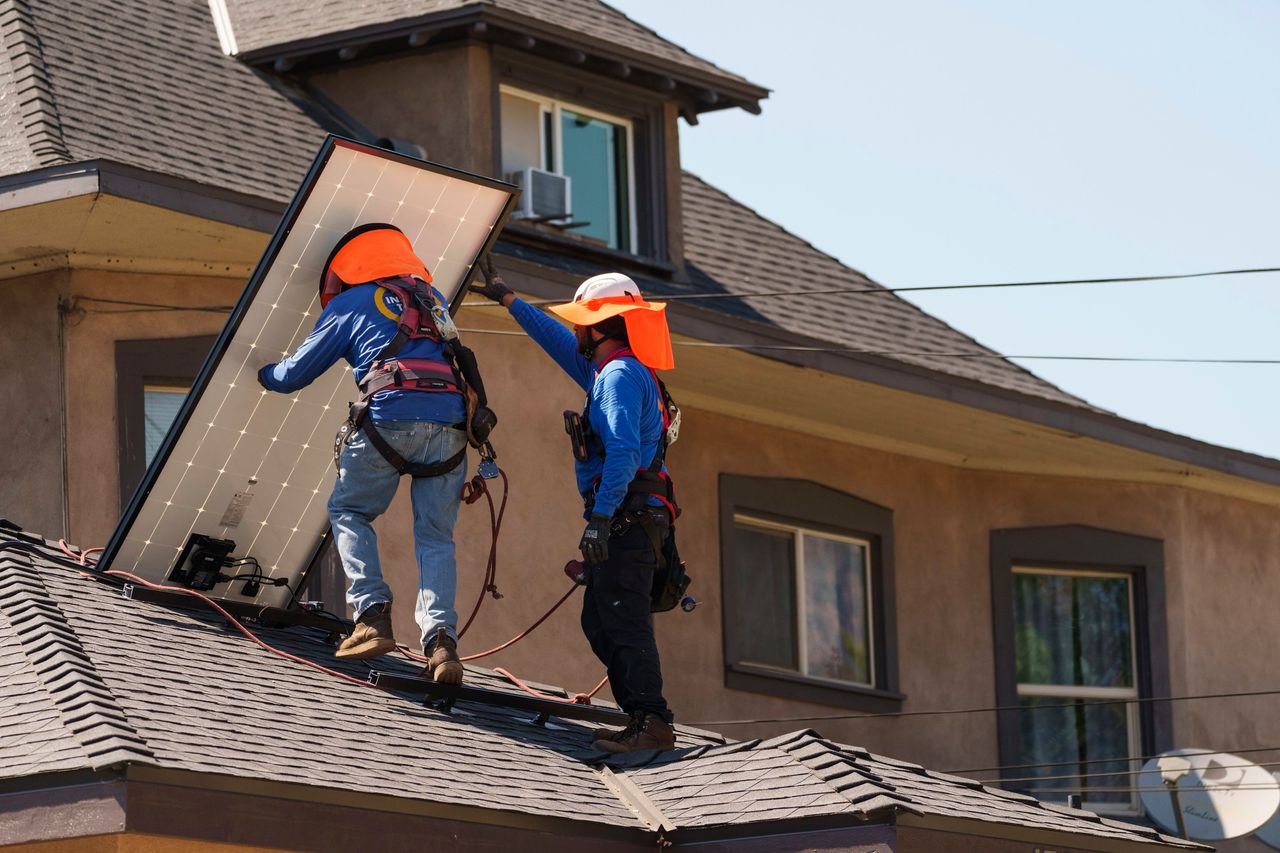
When Tom O’Neill first installed solar panels on his home in northern California in 2019, he recalls thinking that the investment returns were decent and “it’s the right thing to do” for the environment.
Now, the retired information-technology executive would like to get more solar to cover the extra power needed for an electric vehicle he would like to buy, but no longer thinks the economics are feasible. “I’d really have to sharpen my pencil and do the math,” he says.
O’Neill’s about-face, which is mirrored by households and small businesses throughout the U.S., underscores a challenge in the country’s renewables market. Even as the nation accelerates its push for clean energy, the market for rooftop solar is shrinking, pummeled by high interest rates, tight credit and cuts to solar incentives.
For decades, states such as California encouraged homeowners and businesses to stick solar panels on their roofs and carports with incentives that paid generously for the power those systems sent to the grid. The idea was that consumers could offset the cost of most or all of their electric bills, greatly reducing the time it took to break even on their investments and making solar very attractive.

Now financing that investment has become more challenging for consumers, just as some utilities are becoming stingier with their payments to residential solar owners.
The amount of solar power U.S. homeowners install could shrink 13% this year, as forecast by the trade group Solar Energy Industries Association and consulting firm Wood Mackenzie. More than a hundred solar contractors have already gone out of business during the past year as demand dried up, according to data tracked by Solar Insure, a company that monitors residential solar installations and helps fix problems.
The decline is led by California, which has some of the country’s most ambitious clean-energy targets and more solar panels on homes than any other state. The state accounts for 37% of the country’s residential market, according to SEIA and Wood Mackenzie.
The state has installed so many panels that it has a glut of solar power during the day. Last year, California implemented new rules that cut the amount of compensation most rooftop solar owners get for the electricity they send to the grid by 75% or more to manage the oversupply and soaring costs for upgrading the grid.
Residential solar sales have dropped to a quarter of what they were a year ago, and more than a fifth of the state’s solar contractors have been laid off, according to some estimates.
“It was like getting a gut punch,” says Carlos Beccar, marketing director of Fresno-based Energy Concepts, a solar installer that had to lay off more than half its 75 employees after sales plummeted as much as 90% following the new rules.

“California has done more for the solar industry than any other state in the nation,” said a spokesperson for the California Public Utilities Commission, a regulator. “Now, we’re focused on modernizing programs and policies to promote solar and battery storage, strengthen grid reliability, and curb electricity costs for all Californians.”
Solar homeowners still save as much or more on their utility bills now as they did in 2019, under previous rules, according to a study from the University of California, Berkeley, because electricity rates have gone up so much during the past few years.
California’s experience could foreshadow what the rest of the country will face as it deals with rising costs of grid and transmission upgrades along with higher levels of solar, which only produces energy during the day.
The state’s utility companies are increasing rates fast as they look for money to bulk up the power grid as well as bolster it against wildfires. Rooftop solar owners weren’t paying enough toward such costs, the companies claim—an argument that many consumer advocates dispute.
At the same time, California’s solar growth is outpacing the ability of its grid to handle it. The state already supplies more than a third of its power with renewables, and it plans to raise that ratio to 60% by 2030. But because the state’s grid can’t absorb all the solar power generated during the day, it ends up throwing increasing amounts of it away or curtailing it.
Part of the rationale behind the state’s new solar billing rules is to encourage households to buy batteries, which can store power for use later.
Other states could also reduce incentives for rooftop solar as the amounts installed rise, says Timothy Fox, a managing director at Washington, D.C.-based research firm ClearView Energy Partners.
Not all of the outlook for solar is gloomy. Utilities and other large-scale power developers deployed a record amount of solar in 2023, and are expected to add another 26% in capacity this year. The U.S. government is offering tax credits of up to 30% of the cost of home solar, making clean energy affordable for some households.
Still, most states in the U.S. are seeing slower rooftop solar sales despite beefy incentives because 90% of such installations are financed with loans or leases, and interest rates have risen a lot, says Ara Agopian, Solar Insure’s CEO.
When David Phippen, a third-generation almond grower in central California, first installed solar panels in 2009 to help power equipment on his farm, he recalls thinking it was “the best thing since canned beer.”
Most of that equipment is for removing the hulls and shells of the almonds. It runs after the harvest during the fall and winter, when solar generation is weakest, and is idle during the spring and summer when the sun is strongest. That schedule means Phippen’s solar array largely sends power to the grid half the year, then consumes it the other half.
Under the old solar-compensation rules, the economics worked out. But now that those payments will be slashed, adding more solar no longer makes sense, says Phippen—even though he has more equipment and bigger electricity needs.
“We’re done with our green march,” he says.
Write to Phred Dvorak at [email protected]
News Related-
Russian court extends detention of Wall Street Journal reporter Gershkovich until end of January
-
Russian court extends detention of Wall Street Journal reporter Evan Gershkovich, arrested on espionage charges
-
Israel's economy recovered from previous wars with Hamas, but this one might go longer, hit harder
-
Stock market today: Asian shares mixed ahead of US consumer confidence and price data
-
EXCLUSIVE: ‘Sister Wives' star Christine Brown says her kids' happy marriages inspired her leave Kody Brown
-
NBA fans roast Clippers for losing to Nuggets without Jokic, Murray, Gordon
-
Panthers-Senators brawl ends in 10-minute penalty for all players on ice
-
CNBC Daily Open: Is record Black Friday sales spike a false dawn?
-
Freed Israeli hostage describes deteriorating conditions while being held by Hamas
-
High stakes and glitz mark the vote in Paris for the 2030 World Expo host
-
Biden’s unworkable nursing rule will harm seniors
-
Jalen Hurts: We did what we needed to do when it mattered the most
-
LeBron James takes NBA all-time minutes lead in career-worst loss
-
Vikings' Kevin O'Connell to evaluate Josh Dobbs, path forward at QB
